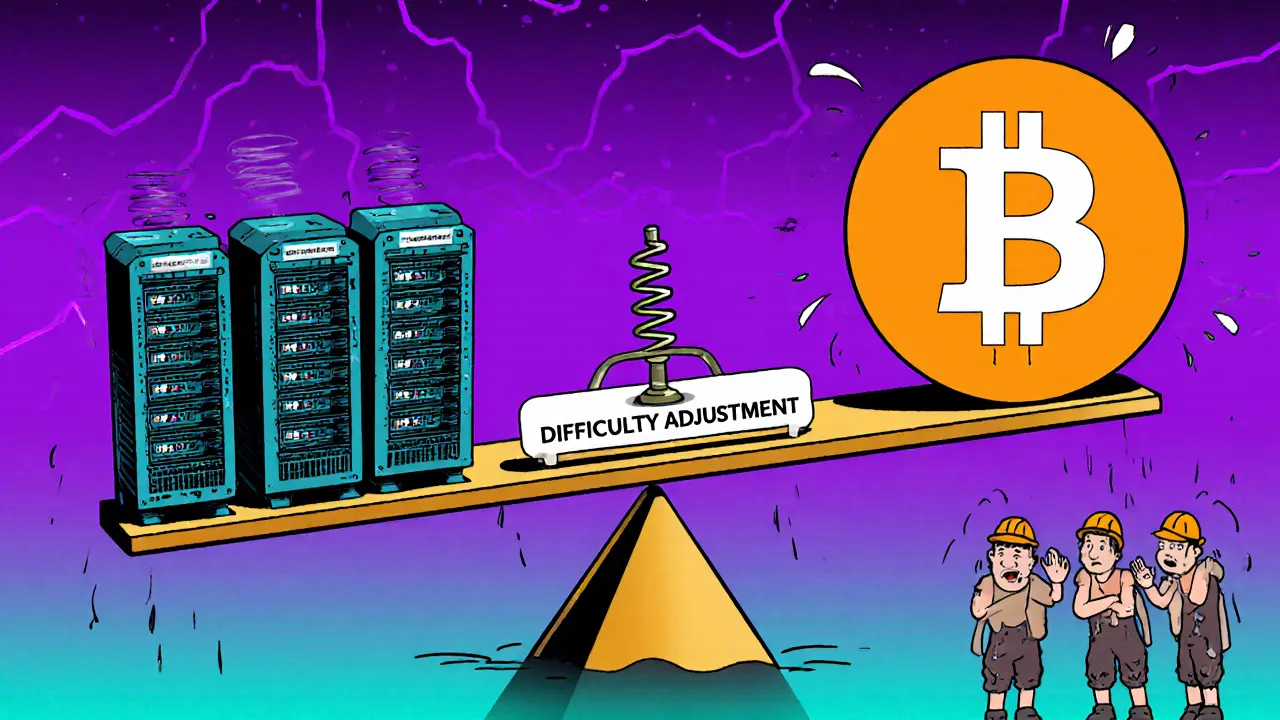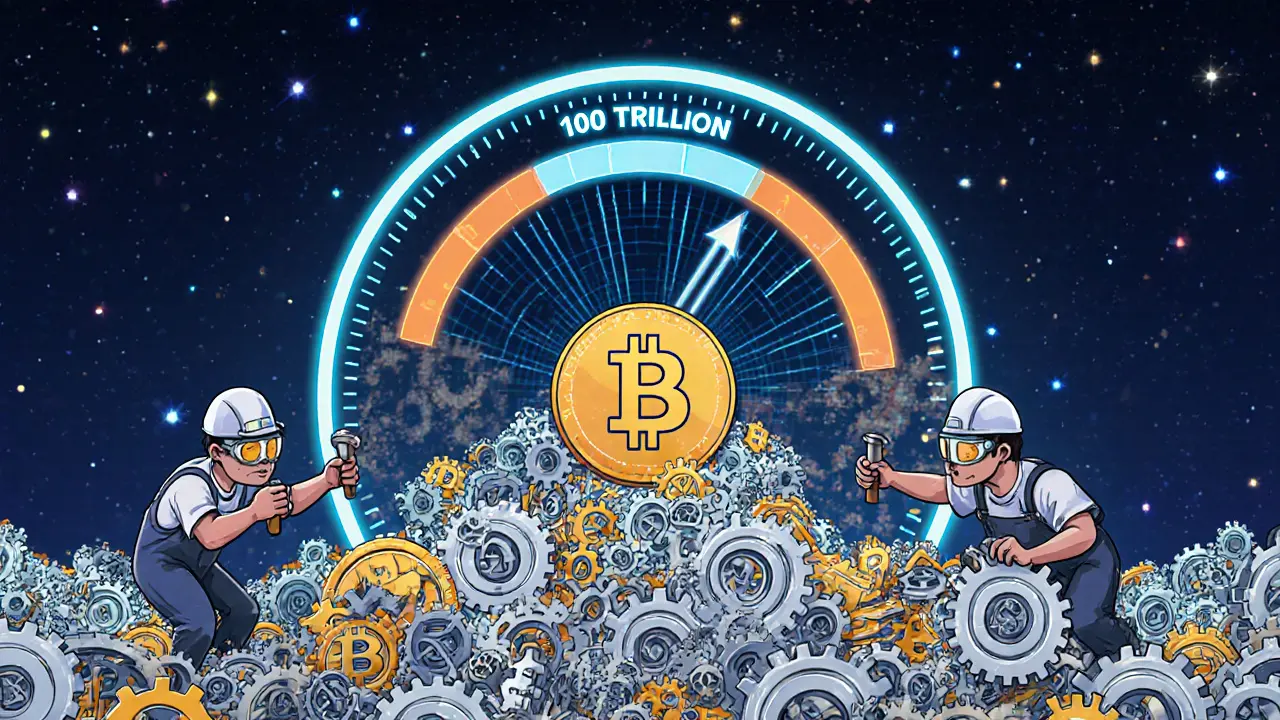Bitcoin Mining Profitability Calculator
Calculate Your Mining Profitability
See how your hash rate, electricity costs, and Bitcoin price affect your mining earnings
Important Note: Difficulty adjusts every 2,016 blocks (about 2 weeks). If your hash rate increases by 10%, difficulty typically increases by about 10%, potentially reducing profitability. Your actual earnings depend on these adjustments.
How Hash Rate & Difficulty Work
For every 10% increase in hash rate, mining difficulty increases by approximately 10% to maintain 10-minute block times. This means your mining power must grow faster than difficulty to maintain profitability.
When you hear that Bitcoin’s hash rate hit a new all-time high, what does that actually mean for the people mining it? And why does mining difficulty keep going up even when the price stays flat? The answer lies in a quiet, automatic system built into Bitcoin’s code - one that keeps the network running smoothly no matter how many miners join or leave. This system is the relationship between hash rate and mining difficulty.
What Is Hash Rate?
Hash rate is the total computing power being used by the Bitcoin network to process transactions and secure the blockchain. Think of it like the number of people trying to solve a giant puzzle at the same time. Each attempt to solve that puzzle is called a "hash," and the hash rate measures how many of those attempts happen every second.
It’s measured in hashes per second. Back in 2010, the whole network might have been doing a few thousand hashes per second. Today, it’s over 1 billion billion hashes per second - that’s 1 exahash per second (EH/s). Most of this power comes from specialized machines called ASIC miners, designed for one thing: crunching numbers as fast as possible.
More hash rate means more security. If someone wanted to attack Bitcoin - say, by trying to reverse transactions - they’d need to control more than half of the network’s total computing power. At today’s hash rate levels, that would cost billions of dollars in equipment and electricity. The higher the hash rate, the more expensive and impossible that becomes.
What Is Mining Difficulty?
Mining difficulty is how hard it is to find a valid block. It’s not a fixed number - it changes automatically. The Bitcoin network adjusts it every 2,016 blocks, which takes about two weeks on average. The goal? Keep the time between blocks at 10 minutes, no matter what.
Here’s how it works: miners are trying to find a hash that’s lower than a target number. The lower the target, the harder it is to find. Difficulty adjusts that target. When the network gets faster (more hash rate), the target gets lower - meaning miners have to work harder. When the network slows down, the target gets higher - making it easier to find blocks.
As of late 2025, Bitcoin’s difficulty is over 100 trillion. That means miners need to try, on average, 100 trillion different hash values before finding one that works. That’s not luck - it’s math. And the system recalculates it every two weeks to stay on track.
The Inverse Relationship: More Hash Rate = Higher Difficulty
The core rule is simple: when more miners join or existing miners upgrade their hardware, the total hash rate goes up. That means blocks would be found faster than every 10 minutes - unless the network does something about it.
So it does. The algorithm detects that the last 2,016 blocks were mined in, say, 12 days instead of 14. It knows: "We’re too fast. We need to make it harder." So it increases the difficulty by a percentage - maybe 15%, maybe 30%. Now, the same mining rig that used to find a block in 10 days will take 13 days. The timing snaps back to 10 minutes per block.
And if miners suddenly shut down - maybe because Bitcoin’s price crashed or electricity got too expensive - the hash rate drops. Blocks start taking longer than 10 minutes. The network notices. Difficulty drops. The puzzle becomes easier. Miners start finding blocks again at the right pace.
This is Bitcoin’s self-balancing engine. No central authority. No human decision. Just code reacting to real-world conditions.

What Drives Changes in Hash Rate?
Hash rate doesn’t change randomly. It moves because of real economic forces:
- Bitcoin’s price: When BTC goes up, mining becomes more profitable. More people buy ASICs. Hash rate rises. When BTC drops, weak miners turn off their machines. Hash rate falls.
- Energy costs: Mining is energy-intensive. In regions with cheap hydro or solar power - like Texas, Kazakhstan, or parts of Canada - mining thrives. If electricity prices spike, miners shut down. Hash rate drops.
- Hardware efficiency: New ASICs come out every year. The latest models deliver more hashes per watt. When these hit the market, even old miners upgrade. The network’s total power jumps. Difficulty follows.
- Regulations and geopolitics: China banned mining in 2021. Hash rate dropped 50% overnight. Miners moved to the U.S., Europe, and the Middle East. Hash rate recovered - and kept growing.
These factors aren’t just background noise - they’re the reason difficulty changes. And those changes directly impact whether a miner makes money or loses it.
How Difficulty Changes Affect Miners
If you’re a small miner with an old ASIC, a sudden difficulty jump can be devastating. Your machine might have been profitable at difficulty 80 trillion. At 100 trillion? You’re spending more on electricity than you earn in Bitcoin.
That’s why most serious miners now join mining pools. Instead of trying to find a block alone, you team up with others. Rewards are shared based on how much hash power you contribute. It’s less glamorous - no big jackpot - but more consistent.
Large mining companies like Marathon Digital, Riot Platforms, and CleanSpark don’t just react to difficulty - they plan for it. They buy ASICs months in advance, lock in cheap power contracts, and schedule maintenance around expected difficulty adjustments. They know the cycle: after a difficulty spike, there’s a 4-6 week window where profitability dips before new efficiency gains kick in.
For new miners, the lesson is clear: don’t buy hardware based on today’s difficulty. Buy it based on where difficulty is likely to be in six months. If you’re not accounting for the next adjustment, you’re gambling.

Why This System Matters for Security
The hash rate and difficulty relationship isn’t just about keeping block times steady. It’s what makes Bitcoin secure.
Imagine if difficulty stayed fixed. If 10,000 new ASICs suddenly flooded the network, blocks could be mined every 2 minutes. That would overwhelm the network. Transactions might get stuck. Wallets might show false balances. The chain could fork.
But because difficulty rises automatically, the network absorbs the shock. The 10-minute rule holds. Transactions keep flowing. The blockchain stays reliable.
And because the hash rate is so high, any attempt to manipulate the chain - like a 51% attack - becomes economically unfeasible. The cost of the hardware and electricity needed just to try would far exceed any potential gain.
This is why Bitcoin has lasted 15 years without a major security breach. It’s not because it’s unbreakable. It’s because breaking it costs more than it’s worth.
What’s Next for Hash Rate and Difficulty?
Hash rate keeps climbing. ASIC manufacturers are pushing toward 50% more efficiency with each new chip. Institutional investors are starting to run their own mining farms. Renewable energy projects are being built just to power them.
Difficulty will keep rising too - likely hitting 150 trillion by late 2026. But the system is designed for this. It’s not a bug. It’s a feature.
Some people wonder: will Bitcoin ever change this mechanism? Maybe. But there’s no real need. The current system has worked perfectly since 2009. It’s simple, transparent, and resilient. Even if quantum computing one day threatens the cryptography behind hashing, the difficulty adjustment itself would still be useful - it’s not tied to the math of SHA-256, just to the timing of blocks.
The takeaway? Don’t think of hash rate and difficulty as separate things. They’re two sides of the same coin. One drives the other. One protects the other. And together, they keep Bitcoin running - reliably, securely, and without a single human in the loop.
Does higher hash rate mean more Bitcoin is created?
No. The number of new Bitcoin created per block is fixed at 3.125 BTC (as of 2025) and halves every four years. Higher hash rate only means more computing power is being used to find those blocks. It doesn’t change how much Bitcoin is rewarded - just how hard it is to earn it.
Can mining difficulty go down?
Yes. If the network’s hash rate drops significantly - say, due to a crash in Bitcoin’s price or widespread power outages - difficulty will automatically decrease. This happened in 2022 after China’s mining ban and again in early 2024 when some miners shut down due to high energy costs. The system always adjusts to keep block times at 10 minutes.
How often does mining difficulty adjust?
Every 2,016 blocks, which takes about two weeks on average. But if miners suddenly join or leave the network, the adjustment can happen faster or slower than two weeks. The system doesn’t care about the calendar - it only cares about how long the last 2,016 blocks took to mine.
Is it still profitable to mine Bitcoin in 2025?
It depends. For individuals with old or inefficient hardware, it’s nearly impossible. For large operations with access to cheap renewable energy and the latest ASICs, it’s still profitable - but only if they manage costs tightly. Profitability calculators now factor in difficulty trends, electricity rates, and Bitcoin’s price over the next six months to give accurate estimates.
What happens if the difficulty adjustment fails?
It hasn’t failed since Bitcoin launched. The algorithm is simple, well-tested, and has run over 1,000 times without error. Even if a large portion of the network went offline, the adjustment would still trigger based on the remaining miners’ data. The system is designed to be robust, not perfect - and it’s proven itself over 15 years.

Leo Lanham
November 6, 2025 AT 06:41Robert Bailey
November 7, 2025 AT 08:07Angie McRoberts
November 7, 2025 AT 20:52Anthony Allen
November 7, 2025 AT 22:20Wendy Pickard
November 9, 2025 AT 09:14Brian Webb
November 10, 2025 AT 17:44Meagan Wristen
November 11, 2025 AT 20:24Natalie Nanee
November 12, 2025 AT 14:20Colin Byrne
November 13, 2025 AT 20:25Becca Robins
November 13, 2025 AT 21:51Angie Martin-Schwarze
November 15, 2025 AT 19:47Chris Hollis
November 16, 2025 AT 00:34Whitney Fleras
November 16, 2025 AT 11:39Janna Preston
November 16, 2025 AT 20:21Alexa Huffman
November 18, 2025 AT 18:21